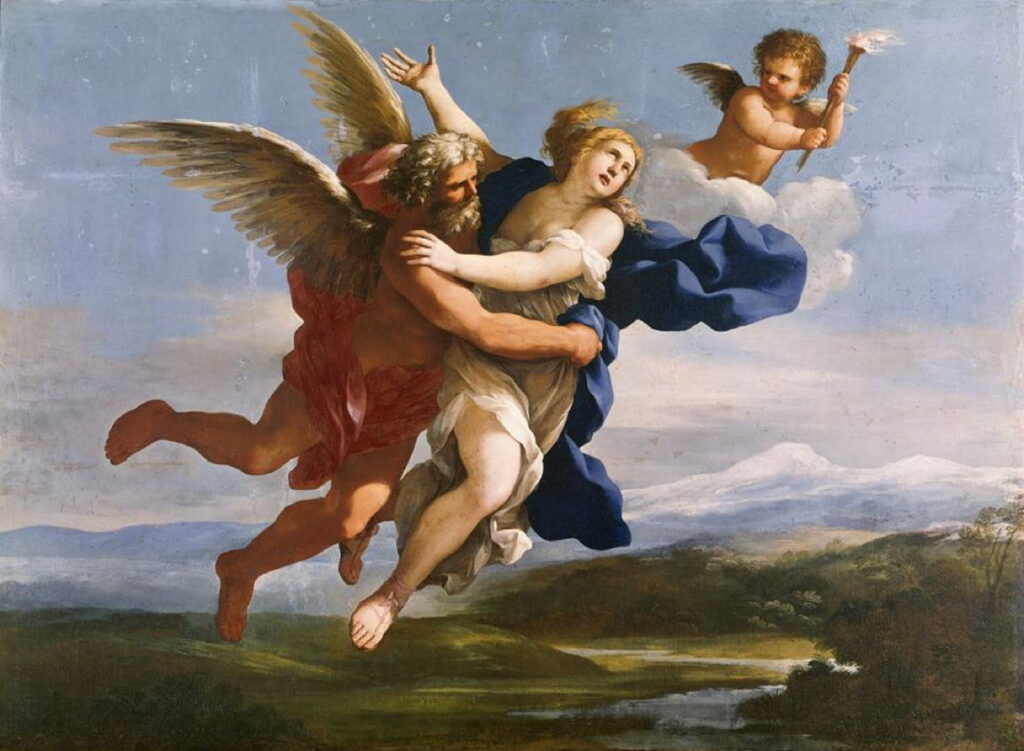Changing Paintings: 29 Boreas and Orithyia

Following Ovid’s long account of the grim story of the rape and mutilation of Philomela, he brings Book 6 of his Metamorphoses to its end on a lighter note, forming a bridge to the opening theme for the next book, Jason and the Argonauts.
Ovid’s tenuous link to introduce the north wind Boreas is that Philomela and Procne were the daughters of Pandion, who died prematurely as a result of the events of the last myth. He was succeeded by Erechtheus, who had four sons and four daughters. Of his daughters, two were egregiously beautiful: Procris, who married Cephalus, and Orithyia, who was betrothed to Boreas.
After the disgrace of Tereus King of Thrace, Boreas, another Thracian, was rejected by Erechtheus. This was despite Boreas’ attempts to reform his habits that normally made him bitterly cold, stormy, and damaging. Boreas decided to take matters into his own hands, unfurled his wings, flew down and abducted Orithyia, who was pledged to be his wife and to bear him twins.
Ovid gives only a brief summary of this vivid story which was popular in classical times, to the point of being the subject of a play that has since been lost. The myth has remained popular in paintings since, and makes an interesting theme with which to trace the history of painting, at least from the Renaissance to the dawn of the twentieth century.
Peter Paul Rubens (1577–1640), Boreas Abducting Oreithya (c 1620), oil on panel, 146 × 140 cm, Akademie der Bildenden Künste, Gemäldegalerie, Vienna, Austria. Wikimedia Commons.
Rubens painted Boreas Abducting Orithyia in about 1620, when he was at the peak of his career. Boreas is shown in his classical guise, as a roughly bearded old man with wings. He is sweeping Orithyia up in his arms, while a cluster of Cupids are engaged in a snowball fight, a lovely touch of humour, and a subtle reference to winter.
Giovanni Francesco Romanelli (1610–1662), Boreas Abducting Oreithyia (date not known), media and dimensions not known, Galleria Spada, Rome. Wikimedia Commons.
A few years later, probably in about 1640, Giovanni Francesco Romanelli painted Boreas Abducting Orithyia. Here Boreas has made his getaway with Orithyia, and is flying over a wintry landscape with a Cupid escort.
Sebastiano Conca (1680–1764), Boreas Abducting Oreithyia (date not known), dimensions not known, Musée du Louvre, Paris. Wikimedia Commons.
Sebastiano Conca’s Boreas Abducting Orithyia from about 1720 shows Boreas taking off with Orithyia from a riverbank and her friends, some of whom are decorating a herm statue at the right.
Francesco Solimena (1657–1747), Boreas Abducting Oreithyia, Daughter of Erectheus (1729), oil, dimensions not known, Azərbaycan Milli İncəsənət Muzeyi, Baku, Azerbaijan. Wikimedia Commons.
Francesco Solimena seems to have been the first painter to depict Boreas as a much younger man, in his Boreas Abducting Orithyia, Daughter of Erechtheus from 1729. He has also elaborated the scene considerably, with Orithyia’s friends tugging at Boreas’ cloak to try to restrain him, Cupid preparing to shoot one of his arrows at Orithyia, and general panic ensuing.
François Boucher (1703–1770), Boreas Abducting Oreithyia (1769), oil on canvas, 273.3 × 205 cm, Kimbell Art Museum, Fort Worth, TX. Wikimedia Commons.
François Boucher delivers a full Rococo interpretation in Boreas Abducting Orithyia (1769). The lead actors are less engaged, with Boreas devoting his efforts to blowing his wind at Orithyia’s friends, and the ground to the right bears witness to his destructive force.
Joseph-Ferdinand Lancrenon (1794-1874), Boreas Abducting Oreithyia (1822), further details not known. Wikimedia Commons.
In 1822, Joseph-Ferdinand Lancrenon’s romantic interpretation of Boreas Abducting Orithyia strips out all the other figures, and shows just the couple. Boreas is now quite youthful, and Orithyia’s eyes are closed as if swooning.
Charles William Mitchell (1854–1903), The Flight of Boreas with Oreithyia (1893), further details not known. Wikimedia Commons.
Charles William Mitchell’s The Flight of Boreas with Orithyia from 1893 returns to a fuller and more classical account. Although not as old as in earlier paintings, Boreas is no longer a stripling. Orithyia is trying to push his head away, and unfasten his right hand from her thigh, but Boreas is just about to take her airborne. Around them the spring flowers and trees are being blasted by his north wind.
Evelyn De Morgan (1855–1919), Boreas and Oreithyia (c 1896), oil on canvas, dimensions not known, De Morgan Centre, London. Wikimedia Commons.
My final selection is Evelyn De Morgan’s Boreas and Orithyia from about 1896. Boreas is now bearing Orithyia aloft, above rugged hills and water. He is younger again, and looks decidedly miserable. In addition to a pair of magnificent wings on his back, he has accessory wings on each heel, and long white and blue sheets wind calligraphically around the couple.
Ovid then closes the book by telling us that their twin sons, Calais and Zeto, grew up to join Jason’s Argonauts.




